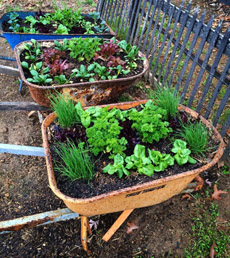TIP OF THE DAY: A Pot Of Herbs
|
We were inspired by the photo below to plant a pot of herbs, otherwise known as container herbs.
If you don’t mind frequent watering, a pot puts fresh herbs at your fingertips—not to mention, provides lovely greenery and fragrance. You can keep one in a sunny kitchen spot, on the back steps, porch or patio, or go whole-hog like our friend Connie has just done and stake out an elaborate garden plot. Your local nursery can provide assistance, and there’s plenty of advice online. Here are the steps to snipping: 1. Pick a sunny spot. Most culinary herbs originated in the Mediterranean and other sun-drenched regions, so they need at least eight hours of sunlight a day. 2. Seeds versus plants. Seeds typically need to be started indoors one to two months before it’s warm enough to move them outside. At this point in the season, look for plants (they’re also easier for beginners). 3. The right container. A larger pot of soil or potting mix* dries out more slowly. To keep the plants moist for the longest time, use the largest pot you can. |
Your favorite herbs, ready to snip. Photo courtesy Whiteflower Farm. |
|
|
*For containers, it’s better to use potting mix than potting soil. The latter is often poor quality soil with poor drainage. Potting mix is made mostly from organic matter (peat, composted plant matter) with good drainage. 4. Select your herbs. They should, of course, be the ones you use most often. Basil, rosemary, thyme and parsley are popular. We use chives every day for flavor or garnish. Don’t be seduced into planting something you don’t use, under the theory that if you have it, you’ll cook with it. Odds are that you won’t. 5. Choose watering-compatible herbs. That is to say, plant together herbs that require the same amount of watering. For example, basil likes more water, but rosemary likes drier soil. To keep the basil happy, you’d be over-watering the rosemary. Separate pots are called for. |
||

